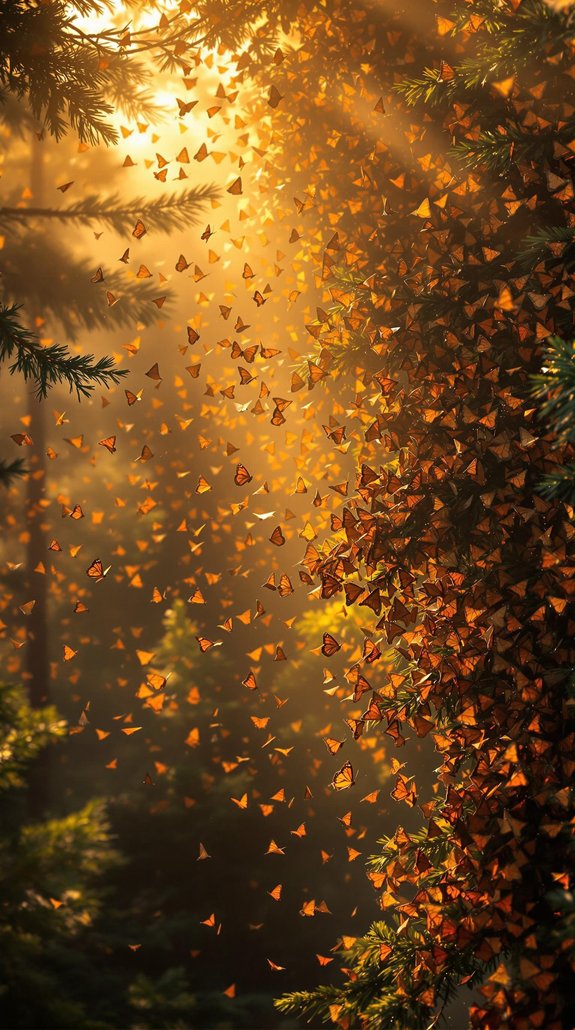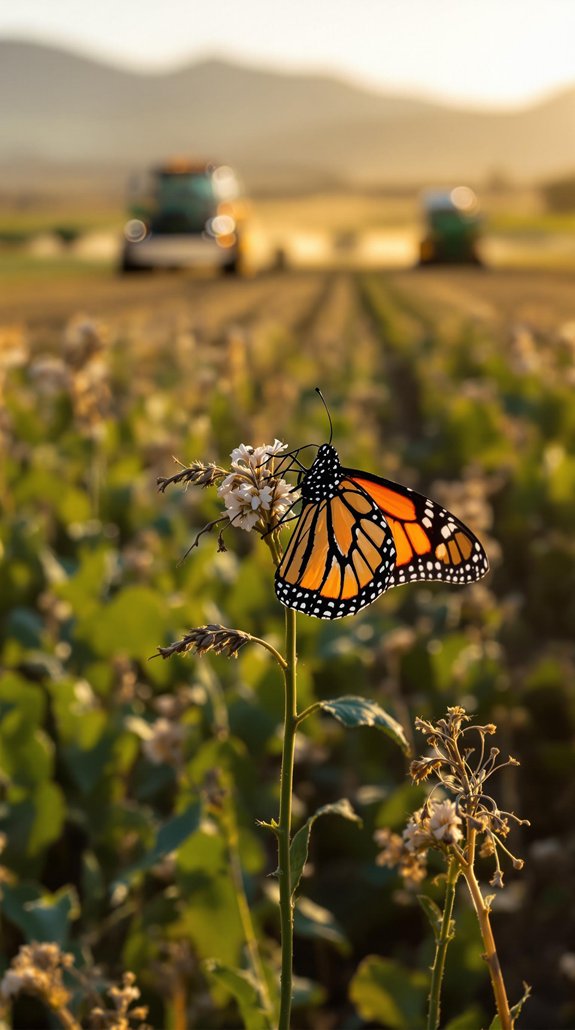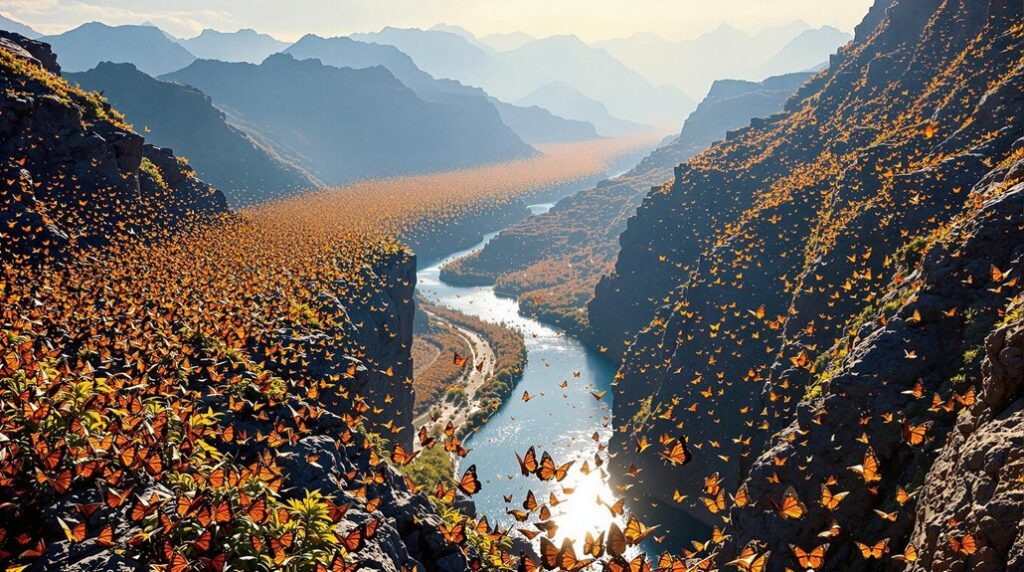You’ll find monarch butterflies follow two main migration paths across North America. Eastern monarchs travel 3,000 miles from Canada to Mexico’s oyamel fir forests, while western populations journey 300 miles to California’s coastal groves. They navigate using sun compass systems in their antennae and magnetic cues during cloudy weather. This multigenerational journey spans four generations, with only the final generation surviving winter. These remarkable routes face mounting threats from habitat loss and climate change.
Eastern and Western Migration Routes

If you’ve ever watched a monarch butterfly flutter past on a crisp autumn day, you’re witnessing one of nature’s most remarkable journeys unfold.
Eastern monarchs initiate an epic 3,000-mile trek to central Mexico’s mountains, while their western cousins travel just 300 miles to California’s coast. The Rocky Mountains create a natural divide between these populations, directing eastern butterflies toward Mexico and western ones toward Pacific overwintering sites.
You’ll find distinct migration corridors on either side of the Rockies, with fall tracking maps revealing separate flight paths. Eastern monarchs seek shelter in oyamel fir trees at elevations around 3,000 meters, where they form massive clusters for protection against winter elements.
Though rare cross-mountain movements occur, these populations maintain their distinct routes. Despite behavioral differences in migration distance and flight patterns—eastern monarchs sustain longer flights while western ones use burst patterns—genetic studies confirm they’re the same species.
Multigenerational Journey Process
Unlike most migrations you might observe in nature, the monarch butterfly’s journey spans multiple generations—no single butterfly completes the entire round trip.
When you trace their path, you’ll discover that females leaving Mexico initiate northward movement, laying eggs in Texas and Oklahoma. Their offspring continue pushing north, reaching breeding territories across the United States and Canada through two or three successive generations.
Each generation lives under two months during active breeding season, making the complete migratory loop impossible for any individual. The exceptional fourth generation, however, enters diapause and survives seven to eight months, enabling them to complete the southern migration to overwintering grounds.
You’re witnessing inherited navigational instincts at work—butterflies that have never visited overwintering sites somehow find their way to Mexico or California. This remarkable intergenerational relay depends entirely on milkweed availability along the route, as monarchs can’t complete their life cycle without these essential host plants.
Overwintering Site Characteristics

The monarchs that survive this multigenerational journey must find precise environmental conditions for winter survival.
Surviving monarchs require exact environmental conditions to endure winter’s harsh challenges.
You’ll find eastern populations clustering at 2,890–3,000 meters in Mexico’s Transvolcanic mountains, where oyamel fir forests create perfect microclimates. These sites avoid freezing temperatures while cooling monarchs’ metabolism to conserve energy. During this period, monarchs enter reproductive diapause, ensuring they don’t waste energy on breeding until spring arrives.
You’d notice millions covering entire tree trunks, using collective body warmth for thermoregulation. The oyamel firs’ flexible branches support massive clusters without breaking, while dense canopies block harsh winds and snow.
Steep slopes of 23–26° with southern exposure maximize sunlight and minimize frozen precipitation. Near streams guarantee year-round humidity.
Western monarchs choose California’s coastal eucalyptus, Monterey pine, and cypress forests.
Both populations rely on multi-layered forests where understory vegetation provides emergency shelter for fallen butterflies.
When you consider the monarchs’ extraordinary 3,000-mile journey, their navigation precision becomes even more remarkable.
They’re using a time-compensated sun compass that processes light through compound eyes and antennal photoreceptors. You’d find their antennae contain circadian clocks that adjust for the sun’s daily movement, ensuring they maintain correct headings throughout their flight.
During cloudy conditions, they’ll switch to their magnetic compass system, detecting Earth’s magnetic field through cryptochrome proteins.
Their central complex integrates both sensory inputs, computing precise directional headings. They’re also following geographic features like the Appalachians, which funnel them southward through predictable corridors.
You’ll notice they exploit thermal winds for altitude gains and track milkweed growth patterns that correspond to seasonal climate shifts. When course corrections become necessary, monarchs don’t simply take the shortest route but instead navigate around a separation point in their visual field that shifts position throughout the day.
Timing and Seasonal Triggers
Beyond their sophisticated navigation systems, monarchs rely on precise environmental signals to coordinate their continental movements.
You’ll notice that shortening daylight and cooling temperatures in fall trigger southern migration, while reproductive diapause develops in monarchs emerging after mid-August. This halts reproduction, conserving energy for the journey ahead.
In spring, rising temperatures and increasing daylengths prompt diapause cessation, initiating northward movement.
The first wave departs overwintering sites between late February and early April, reaching Texas by mid-March. Their offspring constitute the second generation, completing recolonization by early June.
For the southern journey, you’ll observe peak migration during September and October. Fall migration specifically occurs from September to November, with routes carefully documented through tagging and observation programs.
Eastern populations travel up to 3,000 miles to Mexico, while western monarchs head to coastal California.
These combined environmental cues—temperature, light, and air currents—orchestrate this remarkable phenomenon.
Physical Adaptations for Long-Distance Flight
Monarchs possess remarkable physical adaptations that enable their extraordinary 3,000-mile journeys across North America.
You’ll notice their wings flap 5-12 times per second, slower than most butterflies, conserving precious energy. Their microscopic wing scales don’t just create beauty—they reduce drag and amplify lift forces, maximizing thrust while minimizing effort. Despite their delicate appearance, these wings prove surprisingly durable, though they can lose many scales yet continue flying with reduced efficiency.
When you observe monarchs soaring, they’re using thermal columns and air currents for passive travel. Their compound eyes detect motion and UV light in all directions, helping them navigate and evade predators.
During cold spells, you’d see them shivering—rapid wing movements that generate essential body heat. They’ll bask with wings spread wide to absorb sunlight or cluster in massive roosts, sharing warmth with millions of companions while their camouflaged undersides protect them from detection.
Conservation Threats and Protection Strategies

While you’ve marveled at the monarch’s remarkable flight adaptations, these butterflies now face unprecedented threats that could end their ancient migration forever.
You’re witnessing habitat loss from urbanization and agriculture that’s destroyed critical milkweed patches—the only plant monarch caterpillars can eat.
Urbanization and agriculture have destroyed critical milkweed patches that monarch caterpillars depend on for survival.
Herbicides have eliminated milkweed from farmlands, while logging threatens Mexican overwintering sites. Climate change disrupts migration timing as droughts limit food sources and extreme weather kills millions mid-flight. Rising temperatures are shifting breeding ranges northward, potentially disconnecting monarchs from their traditional overwintering grounds.
You can help through conservation efforts now underway.
Plant native milkweed in your garden, support habitat restoration projects, and participate in citizen science monitoring programs. Proposed Endangered Species Act protections would mandate federal habitat preservation and pesticide restrictions.
Cross-border agreements and protected areas aim to safeguard migration corridors, ensuring these iconic butterflies continue their extraordinary journey for generations.
References
- https://monarchwatch.org/migration/
- https://butterfly.nwf.org
- https://www.fws.gov/media/monarch-butterfly-migration-map
- https://monarchjointventure.org/monarch-biology/monarch-migration
- https://xerces.org/blog/5-monarch-migration-facts
- https://en.wikipedia.org/wiki/Monarch_butterfly_migration
- https://news.emory.edu/features/2020/07/esc-butterfly-genomics/index.html
- https://www.fws.gov/story/2023-07/monarch-butterflies-emerge-closer-look-magnificent-life-cycle
- https://www.treehugger.com/nature-blows-my-mind-multi-generation-tk-mile-monarch-butterfly-migration-4859113
- http://www.beyondabook.org/understanding-the-monarch-migration

Erzsebet Frey (Eli Frey) is an ecologist and online entrepreneur with a Master of Science in Ecology from the University of Belgrade. Originally from Serbia, she has lived in Sri Lanka since 2017. Eli has worked internationally in countries like Oman, Brazil, Germany, and Sri Lanka. In 2018, she expanded into SEO and blogging, completing courses from UC Davis and Edinburgh. Eli has founded multiple websites focused on biology, ecology, environmental science, sustainable and simple living, and outdoor activities. She enjoys creating nature and simple living videos on YouTube and participates in speleology, diving, and hiking.
🌿 Explore the Wild Side!
Discover eBooks, guides, templates and stylish wildlife-themed T-shirts, notebooks, scrunchies, bandanas, and tote bags. Perfect for nature lovers and wildlife enthusiasts!
Visit My Shop →
